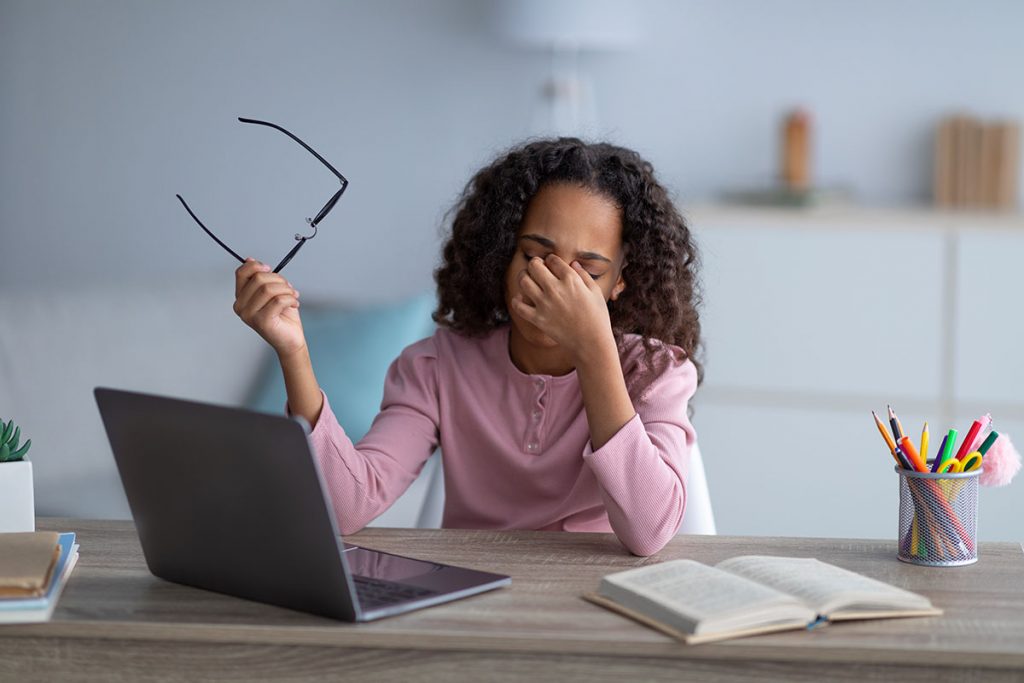How to Protect Your Child's Eyes from Digital Eye Strain

Digital eye strain is not just a problem for adults. Children from toddler age to adolescence can also suffer from digital eye strain at an early age, due to overexposure to or misuse of device screens. Devices such as computers, smartphones, tablets and televisions produce intense artificial light that can hurt your child's eyes and cause mild to severe damage.
But before you ban all devices for your child, you can prevent digital eye strain by teaching your kids how to properly use their devices, which will protect their eyes in the long run. Teaching them how to use digital devices while they are young can help them develop good habits that will preserve their vision for many years to come.
The digital age isn't going away. So, follow these tips on how to protect your child's eyes from digital eye strain.
What Is Digital Eye Strain?
Digital eye strain (also known as computer vision syndrome) is one or more vision problems caused by extended or improper digital device use. Since kids often spend an excessive amount of time in front of their screens, digital eye strain can become a big problem, leading to a variety of vision problems.
What Are the Symptoms of Digital Eye Strain?
The symptoms of digital eye strain may include:
- Eye pain or discomfort
- Eye fatigue
- Headaches
- Blurry vision
- Dry eye
- Nearsightedness
Symptoms start out as mild irritations and slowly develop into severe vision problems. If your child does not correct bad habits or you do not address the symptoms, it could have a lasting impact on your child's eyes. Keep in mind that children do not naturally set their own boundaries. So, it is up to you as a parent to set boundaries and teach your children how to use digital devices properly.
Long-Term Effects of Digital Eye Strain
Research suggests that continued long-term exposure to digital screens that radiate blue wavelength light can cause the following long-term effects.
Retinal or Macular Degeneration
Continued exposure to blue light over time could lead to damaged retinal cells. It can cause vision problems like age-related macular degeneration. Extensive blue-violet light from an LED screen could potentially hasten the onset of age-related macular degeneration.
Cataracts
New research suggests that more young patients are having cataract surgery, which may be linked to increased screen time or improper use of digital devices.
Fortunately, many of the effects of digital eye strain are temporary and can be treated. However, if your child is experiencing symptoms of digital eye strain you need to act immediately and schedule an eye exam in West Florida.
How to Prevent or Reduce Digital Eye Strain
There are some practical things you can teach your child to help form good habits and prevent digital eye strain during screen time:
- Designate certain times of the day for screen time.
- Make sure the computer screen is 25 inches away from your child's face.
- Adjust the screen brightness to a lower setting.
- Adjust the center of the screen to be about 10 to15 degrees below your child's eye level.
- Cut glare by using a matte screen filter. They are available for any digital device.
- Use a larger text size on the screen.
- Teach your child the 20–20–20 rule: Every 20 minutes, look at an object 20 feet away for 20 seconds.
- Put a humidifier in the room where your child uses a computer or other device.
- Make sure the lighting in your child's room is bright enough.
- Schedule regular eye exams for your child.
Schedule an Eye Exam Today
Contact Gulf Coast Vision Center today at one of our Pace, Milton, or Crestview locations or at our Pensacola locations in Nine Mile and East Hill, to schedule a comprehensive eye exam.
